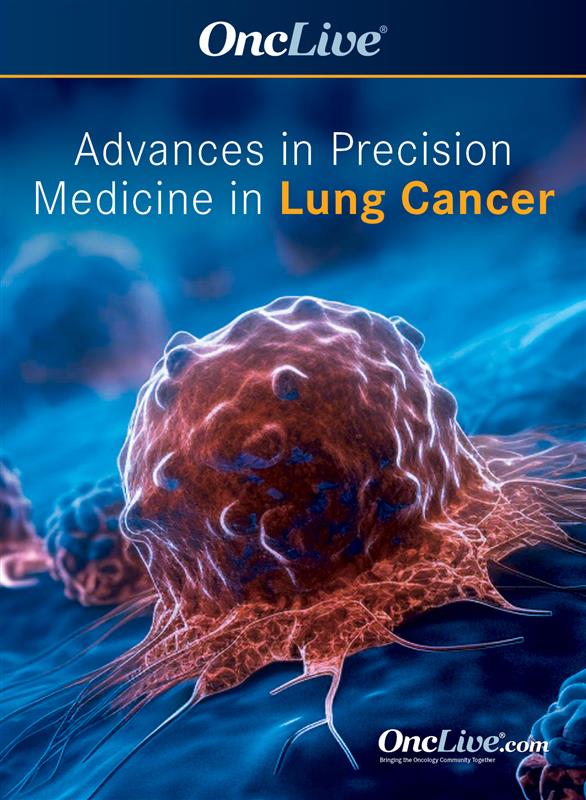Taletrectinib Continues to Demonstrate High Clinical Activity in Advanced ROS1+ NSCLC
Clinicians discuss data on the ROS1 TKI taletrectinib in patients with locally advanced or metastatic ROS1-positive non–small cell lung cancer.
Jason Porter, MD

Treatment with the next-generation ROS1 TKI taletrectinib (AB-106) yielded robust, durable, and consistent overall and intracranial responses in patients with locally advanced or metastatic ROS1-positive non–small cell lung cancer (NSCLC) who were ROS1 TKI naive and with prior exposure to a ROS1 TKI, according to data from the phase 2 TRUST-II trial (NCT04919811) that were presented during the 2023 ESMO Congress.1
Interim results from cohorts 1 and 2 of the trial demonstrated that efficacy-evaluable patients in the TKI-naive population (n = 25) experienced a confirmed overall response rate (cORR) of 92.0% (95% CI, 74.0%-99.0%) per independent review committee (IRC) assessment. This was entirely composed of partial responses (PR).
Patients who were previously exposed to a ROS1 TKI (n = 21) achieved a cORR of 57.1% (95% CI, 34.0%-78.2%), including a confirmed complete response (cCR) rate of 19.0% and a confirmed PR rate of 38.1%. Stable disease was achieved in 28.6% of patients, and 14.3% experienced disease progression.
Moreover, patients with measurable brain metastases who were TKI-naive achieved an intracranial confirmed overall response rate (IC-cORR) of 80% (95% CI, 28.4%-99.5%); the IC-cORR in the TKI-pretreated group was 62.5% (95% CI, 24.5%-91.5%).
“I'm excited about the data that we see with taletrectinib…” Jason Porter, MD, medical oncologist, hematologist, director, Lung Cancer Disease Research Group, West Cancer Center and Research Institute, said regarding the agent’s potential future role in NSCLC. “[These results are in] a small patient population, but when you're that patient, you want the best, most effective drug with the least [AEs], as well as the one that's going to keep you safe by working in your central nervous system [CNS]. It’s got a bright future,” he added.
In August 2022, the FDA granted taletrectinib breakthrough therapy designation for adult patients with advanced or metastatic ROS1-positive NSCLC who had not previously been treated with a ROS1 inhibitor as well as those who had experienced progression on crizotinib (Xalkori).2 The agent was also granted priority review status on December 18, 2023, by China’s National Medical Products Administration for patients with advanced or metastatic ROS1-positive NSCLC who were previously treated with ROS1 TKIs.3
Both regulatory decisions were supported by initial data from TRUST-1, in which TKI-naive and -exposed patients experienced an IRC-assessed cORR of 92.5% (95% CI, 83.4%-97.5%) and 52.6% (95% CI, 35.8%-69.0%), respectively.4
“Some of the ROS1 inhibitors are also NTRK inhibitors. Although inhibiting NTRK allows you to use the drug in an NTRK fusion–positive cancer, it also introduces some [neurologic] toxicities. Therefore, the selectivity of taletrectinib hopefully leads to less dizziness, less of those neurologic effects,” said Stephen V. Liu, MD, an associate professor, of medicine, Georgetown University, director, Thoracic Oncology, head, Developmental Therapeutics, Georgetown Lombardi Comprehensive Cancer Center. “The key [question when] looking at ROS1 inhibition is: can we deliver something [that is] effective over time and is well tolerated to maintain quality of life?”
In TRUST-II, investigators aimed to validate results from the TRUST-I trial in a global population. The data cutoff date for the current analysis was July 12, 2023.1
TRUST-II is a global, multicenter, open-label, single-arm study that enrolled patients at least 18 years of age with locally advanced or metastatic NSCLC, an ECOG performance status of 0 or 1, at least 1 measurable lesion, and evidence of ROS1 fusion in tumor tissue. Notably, patients displaying stable CNS involvement were allowed to enroll in the study.
“That's critical for any drug being developed in this space. It is not going to be useful to us unless it's very active in the brain,” Liu emphasized during an interview with OncLive®.
Patients were enrolled onto 1 of 4 patient cohorts, and all received 600 mg of oral taletrectinib once a day in 21-day cycles. The cohorts included patients with NSCLC who were TKI naive and had received no more than 1 prior line of chemotherapy (cohort 1), exposed to 1 prior ROS1 TKI and no more than 1 prior line of chemotherapy (cohort 2), or exposed to 2 or more prior ROS1 TKIs and no more than 1 prior line of chemotherapy (cohort 3). Cohort 4 comprised patients with ROS1-positive solid tumors, or ROS1-positive NSCLC who were ineligible for cohorts 1 through 3. Patients with NSCLC were eligible if previously treated with no more than 3 prior ROS1 TKIs and 2 lines of chemotherapy.
The trial’s primary end point was IRC-assessed cORR per RECIST 1.1 criteria. Key secondary end points included duration of response (DOR), disease control rate (DCR), intracranial cORR, progression-free survival (PFS), overall survival (OS), time to response (TTR), and safety.2 All patients who received 1 or more doses of taletrectinib were evaluable for safety.
A total of 46 patients were enrolled in the study at the time of data analysis, 25 of whom were in cohort 1 and 21 who were included in cohort 2. The median age of patients was 58 years old (interquartile range, 52.8-67.0), 46% were female, and 63% had an ECOG performance status of 1. Half of the patients were never smokers, followed by former smokers (46%) and current smokers (4%). Fifty-two percent of patients who previously had chemotherapy and 52% who had brain metastasis were TKI-exposed. Notably, 81% and 19% of patients in cohort 2 had previously received crizotinib or entrectinib (Rozlytrek), respectively.
Additional data showed that the median PFS was not reached (NR; 95% CI, 12.0-NR) and the 12-month PFS rate was 82.3% (95% CI, 59.2%-93.0%) in cohort 1 at a median follow-up of 8.1 months (range, 5.6-11.7). After a median follow-up of 11.7 months (range, 5.5-15.8) in cohort 2, median PFS and PFS rate were 11.7 months (95% CI, 4.0-NR) and 42.6% (95% CI, 18.0%-65.5%), respectively.
Although the median DOR was not mature in either cohort, Kaplan-Meier estimates showed that patients achieved 6- and 12-month DOR rates of 89.5% in cohort 1 and 81.5% in cohort 2, respectively.
In the safety-evaluable population (n = 107), the median duration of treatment exposure was 4.9 months (range, 0.09-18.9). Common any-grade treatment-emergent adverse effects (TEAEs) in 15% or more of this population included alanine aminotransferase increase (64%), aspartate aminotransferase increase (63%), diarrhea (43%), nausea (43%), vomiting (29%), dysgeusia (18.7%), anemia (16.8%), constipation (16.8%), and blood CPK increase (15.0%).
Most patients experienced low-grade TEAEs, although 12% of patients did report a serious AE. The majority of neurologic TEAEs were similarly low grade and less frequently observed. However, 13% of patients experienced dizziness. Dose reductions due to TEAEs occurred in 34% of patients, the most common reason for which was increased liver enzymes (23%). Treatment discontinuation due to TEAEs was observed in 2% of patients, and no drug-related deaths were reported.
“We're seeing a much better safety profile [with taletrectinib] because you're not inhibiting TRK or some of these other kinases. Early data suggest that the safety profile looks pretty good,” said Alexander Drilon, MD, chief of the Early Drug Development Service at Memorial Sloan Kettering Cancer Center in New York. “It's good to hear that there are other options coming down the pike for patients with ROS1 fusion–positive cancers.”
Christine Bestvina, MD, assistant professor of medicine, hematology, and oncology (cancer), University of Chicago Medicine Comprehensive Cancer Center added that taletrectinib does have “some impressive response rates from what we’ve seen early on, and it looks like it has significant CNS efficacy. The side effects are [also] a little bit different than what we've seen with some of the prior TKIs. I'm not quite sure where taletrectinib is going to fit in [to the paradigm in light of] the approval of repotrectinib [Augtyro]. There's always going to be a balance of toxicity and efficacy, so I think [its role is] still to be determined.”
References
- Efficacy and safety of taletrectinib in patients (Pts) with ROS1+ non-small cell lung cancer (NSCLC): Interim analysis of global TRUST-II study. Ann Oncol. 2023;34(2):S755-S785. doi:10.1016/annonc/annonc1331
- AnHeart Therapeutics receives FDA breakthrough therapy designation for taletrectinib in ROS1-positive non-small cell lung cancer. News release. AnHeart Therapeutics. August 3, 2022. Accessed November 2023, 2022. https://www.anhearttherapeutics.com/news/press-releases/080322/
- Innovent and AnHeart Therapeutics announce the National Medical Products Administration of China has granted taletrectinib (ROS1 Inhibitor) priority review designation. News Release. PRNewswire. December 18, 2023. Accessed December 20, 2023. https://www.prnewswire.com/news-releases/innovent-and-anheart-therapeutics-announce-the-national-medical-products-administration-of-china-has-granted-taletrectinib-ros1-inhibitor-priority-review-designation-302017538.html#:~:text=In%20March%202022%2C%20taletrectinib%20was,TKIs%20(TKI%2Dna%C3%AFve).
- Li W, Yang N, Li K, et al. Updated efficacy and safety of taletrectinib in patients with ROS1+ non–small cell lung cancer. J. Thor Onc. 2023;18(4):S47-S48. doi:10.1016/S1556-0864(23)00268-X




